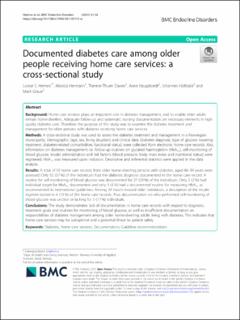| dc.description.abstract | Background
Home care services plays an important role in diabetes management, and to enable older adults remain home-dwellers. Adequate follow-up and systematic nursing documentation are necessary elements in high quality diabetes care. Therefore, the purpose of this study was to examine the diabetes treatment and management for older persons with diabetes receiving home care services.
Methods
A cross-sectional study was used to assess the diabetes treatment and management in a Norwegian municipality. Demographic (age, sex, living situation) and clinical data (diabetes diagnose, type of glucose lowering treatment, diabetes-related comorbidities, functional status) were collected from electronic home care records. Also, information on diabetes management; i.e. follow-up routines on glycated haemoglobin (HbA1c), self-monitoring of blood glucose, insulin administration and risk factors (blood pressure, body mass index and nutritional status) were registered. HbA1c was measured upon inclusion. Descriptive and inferential statistics were applied in the data analysis.
Results
A total of 92 home care records from older home-dwelling persons with diabetes, aged 66–99 years were assessed. Only 52 (57 %) of the individuals had the diabetes diagnosis documented in the home care record. A routine for self-monitoring of blood glucose was documented for 27 (29 %) of the individuals. Only 2 (2 %) had individual target for HbA1c documented and only 3 (3 %) had a documented routine for measuring HbA1c as recommended in international guidelines. Among 30 insulin treated older individuals, a description of the insulin regimen lacked in 4 (13 %) of the home care records. Also, documentation on who performed self-monitoring of blood glucose was unclear or lacking for 5 (17 %) individuals.
Conclusions
The study demonstrates lack of documentation in home care records with respect to diagnosis, treatment goals and routines for monitoring of blood glucose, as well as insufficient documentation on responsibilities of diabetes management among older home-dwelling adults living with diabetes. This indicates that home care services may be suboptimal and a potential threat to patient safety. | en_US |

